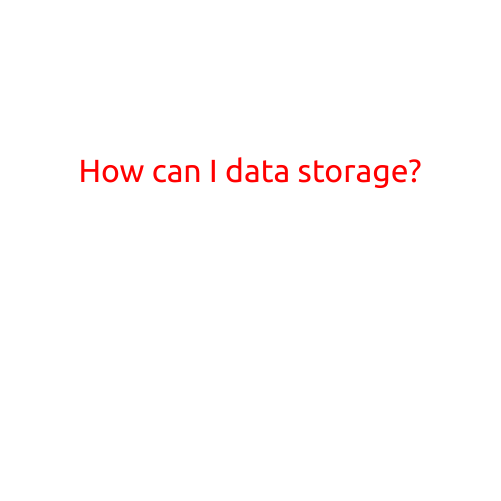
How Can I Data Storage?
In today’s digitally-driven world, data storage has become a crucial aspect of our daily lives. With the exponential growth of digital data, storing and managing it efficiently has become a major challenge. In this article, we will explore the various options and methods of data storage, helping you to understand the best approach for your needs.
What is Data Storage?
Data storage refers to the process of storing digital data in a physical or virtual medium, making it accessible for retrieval and use when needed. This can include written documents, images, videos, audio files, emails, and other forms of digital data.
Types of Data Storage
There are several types of data storage, each with its own advantages and disadvantages. Some of the most common types include:
- Flash Drives: Portable storage devices that use flash memory to store data. They are compact, lightweight, and easy to use, making them a popular choice for storing small amounts of data.
- Hard Drives: Internal or external storage devices that use magnetic disks to store data. They are larger and more powerful than flash drives, making them suitable for storing larger amounts of data.
- Solid-State Drives (SSDs): A type of storage device that uses flash memory to store data, offering faster read and write speeds than traditional hard drives.
- Cloud Storage: A model of data storage where digital data is stored in remote servers accessed over the internet. Popular cloud storage options include Google Drive, Dropbox, and Microsoft OneDrive.
- Optical Storage: A method of storing data on optical discs such as CDs, DVDs, and blue-ray discs.
- Network Attached Storage (NAS): A storage device connected to a network, allowing multiple devices to access and share files.
Benefits of Data Storage
Data storage offers numerous benefits, including:
- Data Backup: Regularly backing up data ensures that it is safe and can be recovered in case of data loss or corruption.
- Data Security: Storing data in a secure location, such as a encrypted cloud storage or a locked cabinet, ensures that it is protected from unauthorized access.
- Data Sharing: Data storage allows multiple users to access and share files, making collaboration and teamwork more efficient.
- Data Archiving: Archiving data helps to free up storage space and reduces the risk of data loss or corruption.
How to Choose the Right Data Storage Method
When choosing the right data storage method, consider the following factors:
- Size of Data: Determine the amount of data you need to store and choose a storage method that can accommodate your needs.
- Accessibility: Consider how often you need to access your stored data and choose a method that allows easy retrieval.
- Security: Choose a storage method that offers adequate security measures to protect your data from unauthorized access.
- Cost: Data storage methods vary in cost, so consider your budget when making a decision.
Conclusion
In conclusion, data storage is an essential aspect of our digital lives. By understanding the various options and methods of data storage, you can choose the best approach for your needs. Whether you need to store small amounts of data or large amounts, there is a data storage method suitable for you. Remember to consider factors such as size of data, accessibility, security, and cost when making your decision.





